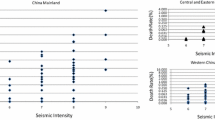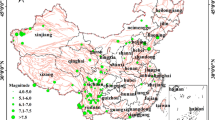Abstract
In order to estimate the human loss after an earthquake to address risk mitigation and response measures, appropriate models should be developed based on local conditions. In this paper, an empirical model for estimating the mortality rate based on shaking related parameter (PGA) is presented for Iran. For this purpose, a reliable fatality database of past earthquakes occurred in the country (between 1962 and 2017) along with corresponding ground motion shaking maps were compiled. It includes information of 88 fatal earthquakes in different cities and villages, compiled from reliable resources. Three distinct functional forms including log-linear, exponential and lognormal cumulative distribution were applied to be fitted to data. To evaluate the appropriateness of different functional forms a residual analysis was performed. The results indicate that the log-linear model shows the best performance. Additionally, a sensitivity analysis was performed to evaluate the impact of events with highest contributions in database on fatality function. The results depicted that excluding data of Bam (2003), Iran Earthquake may reduce fatality ratio to about 5%. This can be related to the paucity of data in high acceleration ranges (near 800 cm/s2) in the database. Finally, two separate curves have been developed for day and night. As expected, the result depicted that fatality ratio in day time is much lower than the night hours. The proposed model can be used for rapid loss assessment in Iran and other countries with similar construction types to provide an initial estimation of deaths after earthquakes or determining the priorities for risk reduction.









Similar content being viewed by others
References
Abrahamson NA, Silva WJ, Kamai R (2014) Summary of the ASK14 ground motion relation for active crustal regions. Earthq Spectra 30(3):1025–1055
Aghamohammadi H, Mesgari S, Mansourian A, Molaei D (2013) Seismic human loss estimation for an earthquake disaster using neural network. Int J Environ Sci Technol 10:931–939
Allen TI, Wald DJ (2009) On the use of high-resolution topographic data as a proxy for seismic site conditions (VS30). Bull Seismol Soc Am 99(2A):935–943
Allen TI, Marano KD, Earle PS, Wald DJ (2009) Pager-cat: a composite earthquake catalog for calibrating global fatality models. Seismol Res Lett 80(1):57–62
Amini V (2017) Uncertainty in macroseismic catalogueue for historical and twentieth century earthquake of Iran, Ph.D thesis, in Persian. International Institute of Earthquake Engineering and Seismology
Badal J, Vzquez-prada M, Gonzalez A (2005) Preliminary quantitative assessment of earthquake casualties and damages. Nat Hazards 34:353–374
Bastami M, Soghrat MR (2017) An empirical method to estimate fatalities caused by earthquakes: the case of the Ahar-Varzaghan earthquakes (Iran). Nat Hazards 86(1):125–149
Berberian M, Yeats RS (1999) Patterns of historical earthquake rupture in the Iranian Plateau. Bull Seismol Soc Am 89(1):120–139
Borcherdt RD (1994) Estimates of site-dependent response spectra for design (methodology and justification). Earthq Spectra 10(4):617–653
Christoskov L, Samardjieva E, Solakov D (1990) Improvement of the approach in determining the possible human losses during strong earthquakes. Bulg Geophys J 4:85–92
Cua G, Wald D (2008) Calibrating PAGER (Prompt Assessment of Global Earthquakes for Response) ground shaking and human impact estimation using worldwide earthquake datasets: Collaborative research with USGS and the Swiss seismological service. NEHRP Final Report
Ghasemi H, Zare M, Fukushima Y (2008) Ranking of several ground-motion models for seismic hazard analysis in Iran. J Geophys Eng 5(3):301–310
Ghasemi H, Zare M, Fukushima Y, Koketsu K (2009) An empirical spectral ground-motion model for Iran. J Seismol 13(4):499–515
Jaiswal K, Wald D (2010) An empirical model for global earthquake fatality estimation. Earthq Spectra 26(4):1017–1037
Jaiswal K, Wald DJ, Earle PS, Porter KA, Hearne M (2011) Earthquake casualty models within the USGS Prompt Assessment of Global Earthquakes for Response (PAGER) system. In: Human casualties in earthquakes, pp 83–94
Kanno T, Narita A, Morikawa N, Fujiwara H, Fukushima Y (2006) A new attenuation relation for strong ground motion in Japan based on recorded data. Bull Seismol Soc Am 96(3):879–897
Kotha SR, Bindi D, Cotton F (2016) Partially non-ergodic region specific GMPE for Europe and middle-East. Bull Earthq Eng 14(4):1245–1263
Kuwata Y, Takada S, Bastami M (2005) Building damage and human casualties during the Bam-Iran earthquake. Asian J Civ Eng (Build Hous) 6:1–19
Lomnitz C (1970) Casualties and behavior of populations during earthquakes. Bull Seismol Soc Am 60(4):1309–1313
Mansouri B, Amini-Hosseini K (2012) Development of residential building stock and population databases and modeling the residential occupancy rate for Iran. Nat Hazards Rev 15(1):88–94
Marza VI (2004) On the death toll of the 1999 Izmit (Turkey) major earthquake, ESC General Assembly Papers. European Seismological Commission, Potsdam
Masson F, Anvari M, Djamour Y, Walpersdorf A, Tavakoli F, Daignires M, Nankali H, Gorp SV (2007) Large-scale velocity field and strain tensor in Iran inferred from GPS measurements: new insight for the present-day deformation pattern within Iran. Geophys J Int 170(1):436–440
Montilla JP, Casado CL (2002) Seismic hazard estimate at the Iberian Peninsula. Pure Appl Geophys 159(11–12):2699–2713
Mousavi M, Ansari A, Zafarani H, Azarbakht A (2012) Selection of ground motion prediction models for seismic hazard analysis in the Zagros region, Iran. J Earthq Eng 16(8):1184–1207
NGDC/NOAA “Significant Earthquakes Database”, 2010 online searchable catalogue at http://ngdc.noaa.gov. Last Access: 23 Oct 2017
Nichols JM, Beavers JE (2003) Development and calibration of an earthquake fatality function. Earthq Spectra 19(3):605–633
Petal M (2011) Earthquake casualties research and public education. In: Advances in natural and technological hazards research, pp 25–50
Porter K, Jaiswal K, Wald D, Earle P, Hearne M (2008) Fatality models for the US geological surveys Prompt Assessment of Global Earthquake for Response (PAGER) system. In: 14th World conference on earthquake engineering, Oct 12–17
Rashidabadi M (2018) Evaluation of estimation methods of seismic intensity parameters for rapid damage estimation, Ms. thesis, in Persian. International Institute of Earthquake Engineering and Seismology
Robinson RT, Thomas WM, Tim DRH, Caroline O, Thompson J (2006) A rapid method for estimating expected fatalities from future strong earthquakes. Bull N Z Soc Earthq Eng Methods 5(6):1–7
Samardjieva E, Badal J (2002) Estimation of the expected number of casualties caused by strong earthquakes. Bull Seismol Soc Am 92(6):2310–2322
SCI (2016) Statistical Centre of Iran, vice-presidency for strategic planning and supervision, Tehran, national census of population and housing technical reports, sarshomri 2016 (1395), 2011 (1390), 2006 (1385), 1996 (1375), 1986 (1365), and 1976 (1355): Tehran, SCI, formerly, the plan and budget organization of the imperial government of Iran, statistical Centre. http://www.amar.org.ir/Default.aspx?tabid=116. Accessed 20 Feb 2018
Shapira S, Aharonson-Daniel L, Shohet IM, Peek-Asa C, Bar-Dayan Y (2015) Integrating epidemiological and engineering approaches in the assessment of human casualties in earthquakes. Nat Hazards 78(2):1447–1462
So E, Spence R (2013) Estimating shaking-induced casualties and building damage for global earthquake events: a proposed modeling approach. Bull Earthq Eng 1(1):347–363
Spence R, So E (2009) Estimating shaking-induced casualties and building damage for global earthquake events. Cambridge Architectural Research Ltd, Cambridge
Spence R, So E (2011) Human casualties in earthquakes: modeling and mitigation. In: Proceedings of the ninth Pacific conference on earthquake engineering, Auckland
Utsu T (2017) A list of deadly earthquakes in the world: 1500–2000. In: Lee WK, Kanamori H, Jennings PC, Kisslinger C (eds) International handbook of earthquake engineering and seismology. Academic Press, Amsterdam, pp 691–717. Last Access: 23 Oct 2017
Wald DJ, Quitoriano V, Heaton TH, Kanamori H (1999) Relationships between peak ground acceleration, peak ground velocity and modified Mercalli intensity in California. Earthq Spectra 15:557–564
Wald D, Jaiswal K, Marano K, Earle P, Allen T (2011) Advancements in casualty modeling facilitated by the USGS Prompt Assessment of Global Earthquakes for Response (PAGER) system, pp 221–230
Worden C, Wald D, Allen T, Lin K, Garcia D, Cua G (2010) A revised ground-motion and intensity interpolation scheme for ShakeMap. Bull Seismol Soc Am 100(6):3083–3096
Zafarani H, Mousavi M (2014) Applicability of different ground-motion prediction models for northern Iran. Nat Hazards 73(3):1199–1228
Zafarani H, Luzi L, Lanzano G, Soghrat M (2018) Empirical equations for the prediction of PGA and pseudo spectral accelerations using Iranian strong-motion data. J Seismol 22(1):263–285
Acknowledgements
This study is conducted as part of a research program being implemented in the International Institute of Earthquake Engineering and Seismology (IIEES), Tehran, Iran. Its financial and technical supports are fully acknowledged. The authors also appreciate all those individuals and organizations contributing to the compiling data sets used in the present study, including the Building and Housing Research Center of Iran (BHRC) for providing the recorded ground motion data and Statistical Center of Iran (SCI) for providing the population databases.
Author information
Authors and Affiliations
Corresponding author
Additional information
Publisher's Note
Springer Nature remains neutral with regard to jurisdictional claims in published maps and institutional affiliations.
Rights and permissions
About this article
Cite this article
Firuzi, E., Amini Hosseini, K., Ansari, A. et al. An empirical model for fatality estimation of earthquakes in Iran. Nat Hazards 103, 231–250 (2020). https://doi.org/10.1007/s11069-020-03985-y
Received:
Accepted:
Published:
Issue Date:
DOI: https://doi.org/10.1007/s11069-020-03985-y




